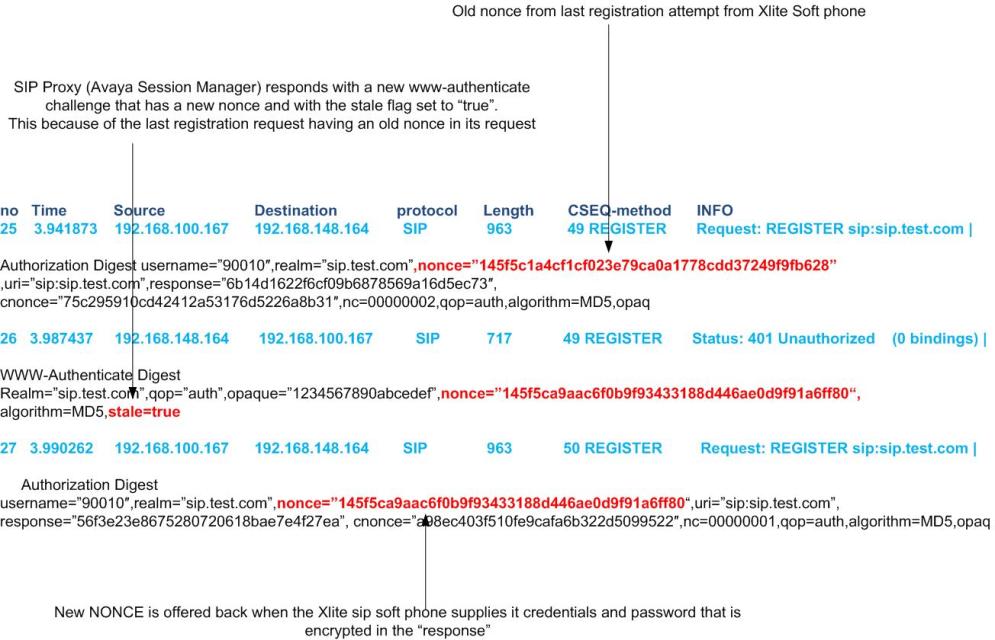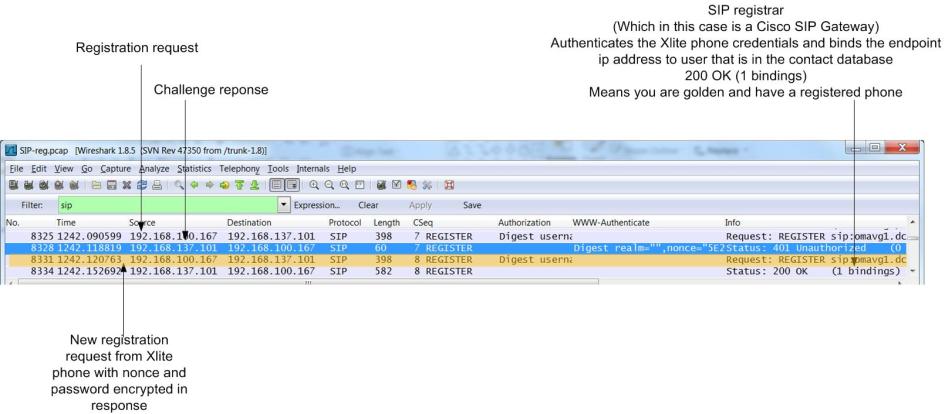The WWW-Authenticate header consists of at least one challenge that indicates the authentication scheme(s) and parameters applicable to the Request-URI. More...
http://sofia-sip.sourceforge.net/refdocs/sip/group__sip__www__authenticate.html
https://allenluker.wordpress.com/2014/07/16/sip-digest-authentication-part-1-sip-registration-method/
An analysis of SIP Digest Authentication used in the SIP Registration Method
SIP authentication model based on the HTTP digest authentication described in the RFC 2617
This post is intended to be a neutral in its analysis of the vendors SIP registration process and the various vendors registration responses as analyzed in wire shark using the Conterpath free X lite soft phone. I have to admit that I am not very neutral about Counter path products I think there SIP soft phones are the best to benchmark other SIP phones.
I registered the X lite phone to a Cisco ISR gateway that is enabled as sip registrar, an Avaya Session Manager and for more comparisons a lab Cisco Call Manager and a version 5 Nortel NRS. The IP addresses used in these labs have been changed so that there is no possibility if revealing any proprietary information. You may also noticed paste overs on some of the screenshots, this also to avoid revealing any proprietary information.
You will see how Digest Access Authentication is used the SIP account password will be sent encrypted (normally as md5 hash of the password and some other values) and not sent in clear text.
Two types of SIP authentication that uses Digest authorization with MD5
- Registration method
When a SIP User Agent sends Registration Request to SIP Registrar Server it will respond with a 401 Unauthorized with a challenge to provide credentials.
- Proxy Authentication of outbound calls (which I will cover in another post)
When a SIP User Agent sends an Invite to a SIP server that will proxy the invite to a SIP Gateway, the SIP server will send back 407 Proxy Authentication Required
A RFC compliant SIP User-Agent will either: 1) Send ACK response to the server response to close the transaction. Or 2) Repeat the initial request and provide additional Authorization (for 401) or Proxy-Authorization (for 407) header in this message. This request must be sent with the same Call-ID and To, From headers as the original one and the CSeq (Command Seq) value must be incremented as seen in the wire shark trace below: 

SIP Authentication Headers
The “WWW-Authenticate” header
- Used by SIP Registrar Server this header is in the 401 unauthorized challenge for credentials from the User-Agent when the User Agent has made a request for registration
The “Proxy-Authenticate” header( will talk about this in another post)
- Used typically when Proxy server is sending request to a gateway that has access to the PSTN network. But it is any call that goes over a SIP trunk to another PBX, Registrar Server that an endpoint exists.
SIP Server (User Agent Server) Challenge Strings
Here is a challenge string taken from a wire shark trace of a Xlite phone registering to a Cisco Gateway:  Server: Cisco-SIPGateway/IOS-15.2.4.M4 WWW-Authenticate: Digest realm=””,nonce=”1ADF55F80288CBA4″,algorithm=MD5,qop=”auth”
Server: Cisco-SIPGateway/IOS-15.2.4.M4 WWW-Authenticate: Digest realm=””,nonce=”1ADF55F80288CBA4″,algorithm=MD5,qop=”auth”
 Server: Cisco-SIPGateway/IOS-15.2.4.M4 WWW-Authenticate: Digest realm=””,nonce=”1ADF55F80288CBA4″,algorithm=MD5,qop=”auth”
Server: Cisco-SIPGateway/IOS-15.2.4.M4 WWW-Authenticate: Digest realm=””,nonce=”1ADF55F80288CBA4″,algorithm=MD5,qop=”auth”Here is the analysis of the string which is color coded to match color of text in string:
Challenge type used by the SIP Registrar server is: “WWW-Authenticate” Indicator of Authentication Scheme which is “Digest” Realm is the Protection Domain/or what I call the Dialing Domain ( in this string that I captured from a phone registered to a Cisco gateway no realm was configured) Nonce(Number Once) that can only be used one time. Every 401/407 challenge will contain a unique Nonce which means any data encrypted with it as only good for a single transaction. Those encrypted credentials become completely worthless after a single use. Hash algorithm (which is MD5) qopIndicates what “quality of protection” the client has applied to the message. Typically it is always”auth” or “auth-int”
Challenge from Avaya Session Manager Server: AVAYA-SM-6.3.4.0.634014
Now the Avaya Session Manager string has a few more items in its Challenge string
WWW-Authenticate: Digestrealm=”sip.test.com”,qop=”auth”,opaque=”1234567890abcedef”,nonce=”145f5ca9aac6f0b9f93433188d446ae0d9f91a6ff80“,algorithm=MD5,stale=true
As with the Cisco Gateway challenge string type is “WWW-Authenticate” This time the realm is defined as it is required in Avaya Session Manager and the realm is “sip.test.com” A new option in the string is opaque=”1234567890abcedef” I find that neither the Cisco Gateway (ISR router) or Cisco Call Manager use the opaque option.
A second new option is “stale” notice in the Avaya SM capture that it is set to true. Typically if the “stale” element is in the string the value will be false. Hold the thought on this will explain why it is set to true in the next section “User Agent Client Response to challenge” opaque A string of data, specified by the server, which should be returned by the client unchanged.( This an extra mechanism that rogue phone would not know when it tried hack the call in progress). The opaque actually makes no sense to me as all Avaya Session Manager captures I have looked at it is always “1234567890abcedef” Stale is either True or false This used to for Server to track when client tries to re-use a Nonce which happens when endpoint Re-registers.
When I tested an old Nortel NRS version 5 it also has an opaque and stale WWW-Authenticate: Digest realm=”sip.lab.com”, nonce=”3f3b346de1b216b59b05daaec5b4b603″, opaque=”62bf8eaf6c0d967565423c4e47a39a8f”, stale=false, algorithm=MD5, qop=”auth”
User Agent Client Response to challenge
Xlite phone response to the challenge from the Cisco SIP gateway
Digest username=”4427″,realm=””,nonce=”63110EC902893319″,uri=”sip:192.168.15.101″,response=”c50963fa128e8db5069e262f176292fe”, cnonce=”a36f404a118bce981fe948ff26be22d4″,nc=00000001, qop=auth,algorithm=MD5 In second Registration request from the User Agent Client (Xlite SIP phone) is the response to the SIP server challenge the: the realm and Nonce are repeated back, then the following new values are added:
- username is provided
- The SIP URI is supplied
- Response contains the encrypted password
- CNONCE (Client NONCE) UAC supplied Nonce to effect final hash algorithm
Xlite phone response to Challenge from Avaya Session Manager User-Agent: X-Lite release 4.5.5 stamp 71236  The
The
Xlite response to the Avaya SM challenge has additional component in the string: NC this is the NONCE count of requests sent by the client and supposedly must be present if qop is present. The nonce-count is used to avoid reply-attacks.
Now to my earlier observation looking at the wireshark snippets below “A second new option is “stale” notice in the Avaya SM capture that it is set to true. ”
WWW-Authenticate: Digest realm=”sip.test.com”,qop=”auth”,opaque=”1234567890abcedef”,nonce=”145f5ca9aac6f0b9f93433188d446ae0d9f91a6ff80″,algorithm=MD5,stale=trueIn this snippet from the wire shark trace we see the Xlite phone (line number 25 and source is 192.168.200.167) initiating a registration attempt with nonce that had been used in a previous registration attempt to Session Manager 192.168.148.164 (destination), notice it is also sending a nc=00000002. This indicates that nonce is being more than one time. Now on line 26 Session Manager responds with a new challenge, notice the nonce value and the stale flag being “true” On line 27 we see that Xlite phone responds to the WWW-authenticate challenge by providing the credentials with the new nonce
Wire Shark Summary of SIP registration
Advertisements



No hay comentarios:
Publicar un comentario